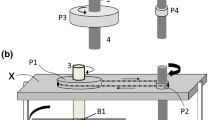Abstract
From a signal methodological perspective, we developed a technique for structural synthesis of a relay current controller in an automatic current-control system for different laws of switching the keys in a valve inverter. The technique consists of several phases: a phase in which timing diagrams of transistor control impulses in the bridge circuit of the valve inverter are constructed, a phase in which the moments of locking and unlocking of the bridge transistors are determined; a phase in which the static characteristics of the relay elements are determined; and a phase in which the number of relay elements of the current controller are minimized and the structure of the controller is formed. Timing diagrams of the transistor control impulses are constructed on the basis of time diagrams, which describe tracking of the control input by the armature current in the direct-current (dc) motors and the armature voltage at the electric-motor armature in all operation modes of the electric drive, and depend on the used law of switching the keys of the bridge circuit in the valve inverter. The moments of locking and unlocking of the inverter bridge transistors are determined using relay elements with an adjustment characteristic of the discontinuous function of a step type, at a smooth alternating signal at the input of the relay element, which is a signal of desynchronization in the automatic currentcontrol system. The technique allows composing the analytical expressions for static characteristics of the relay elements, which define the moments of locking and unlocking the bridge transistors, and minimizing the number of relay elements in the controller. The synthesized relay current controllers with a minimal number of relay elements provide a high accuracy of the armature current in the dc motor in all operation modes of the electric drive.
Similar content being viewed by others
References
Menskii, B.M., Printsip invariantnosti v avtomaticheskom regulirovanii i upravlenii (Invariant Principle in Independent Control), Moscow: Mashinostroenie, 1972.
Okhotkin, G.P., Analysis of current control systems, Elektromekhanika, 1992, no. 3.
Polkovnikov, V.A., Petrov, B.I., Popov, B.N., et al., Elektroprivod letatel’nykh apparatov (Aircrafts Electric Drive), Polkovnikov, V.A., Ed., Moscow: Mashinostroenie, 1990.
Okhotkin, G.P. and Romanova, E.S., The way to analyze keys switching laws of bridge circuit for pulse transducer, Vestn. Chuvashsk. Univ., 2012, no. 3.
Tsypkin, Ya.Z., Releinye avtomaticheskie sistemy (Relay Automated Systems), Moscow: Nauka, 1974.
Okhotkin, G.P., The way to generate a procedure for synthesizing relay controllers for current automated control system under symmetrical and diagonal switching of VPtransistors, Vestn. Chuvashsk. Univ., 2014, no. 2.
Author information
Authors and Affiliations
Corresponding author
Additional information
Original Russian Text © G.P. Okhotkin, S.V. Ugarin, N.A. Galanina, 2017, published in Elektrotekhnika, 2017, No. 7, pp. 15–19.
About this article
Cite this article
Okhotkin, G.P., Ugarin, S.V. & Galanina, N.A. A technique of structural synthesis of a relay current controller in a transistor-based electric drive. Russ. Electr. Engin. 88, 408–411 (2017). https://doi.org/10.3103/S1068371217070148
Received:
Published:
Issue Date:
DOI: https://doi.org/10.3103/S1068371217070148




